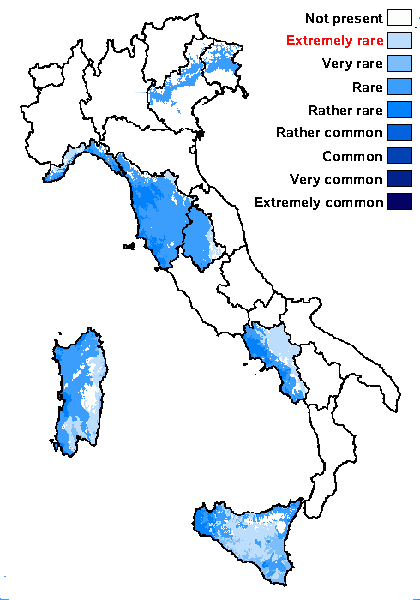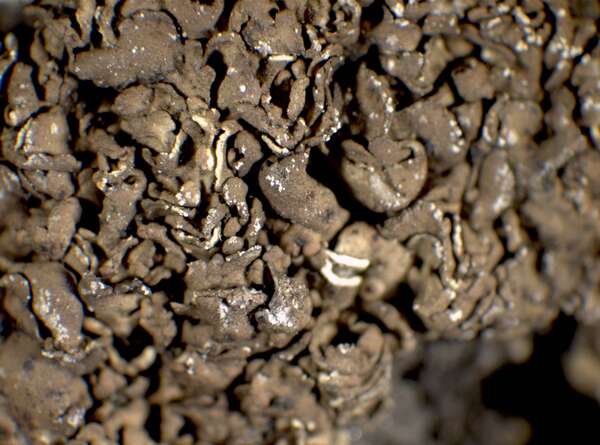Heteroplacidium imbricatum (Nyl.) Breuss
Ann. naturhist. Mus. Wien, 98B: 40, 1996. Basionym: Endocarpon imbricatum Nyl. - Bot. Not.: 161, 1853.
Synonyms: Catapyrenium imbricatum (Nyl.) Clauzade & Cl. Roux; Dermatocarpon imbricatum (Nyl.) Zahlbr.; Endopyrenium imbricatum (Nyl.) Boistel
Distribution: N - VG, Frl (TSB 3062), Ven, Lig. C - Tosc, Umb (Genovesi & al. 2001, Ravera & al. 2006), Sar. S - Camp (Nimis & Tretiach 2004), Si (Nimis & al. 1996b, Grillo & Caniglia 2004, Caniglia & Grillo 2005, Cataldo & Minissale 2015).
Description: Thallus squamulose, pale greyish brown to brownish, dull, rarely faintly pruinose at margin. Squamules 1-3 mm broad, 0.15-0.4 mm thick, rounded to crenulate, concave to convex, but usually flattened, smooth, densely imbricate, forming 2-4 cm wide cushions. Lower surface whitish to yellowish white or very pale brown, attached by 4-5 μm thick, pale rhizohyphae which are usually present only at the base of squamules. Upper cortex paraplectenchymatous 20-40 μm thick, of 4-13 μm wide, angular cells; medulla of globose cells; lower cortex not clearly delimited from the medulla. Perithecia rather rare, laminal, subglobose to pyriform, immersed, to 0.35 mm broad, without involucrellum. Exciple initially pale, then brown, finally dark brown to black; paraphyses absent, substituted by periphyses. Asci 8-spored, clavate, I-, fissitunicate, the wall thickened above, Verrucaria-type. Ascospores 1-celled, hyaline, narrowly ellipsoid, thin-walled, (11-)12-16(-17) x 5-7 μm, biseriately arranged in the asci. Pycnidia dark, immersed, of the Dermatocarpon-type. Conidia subcylindrical, 4-5 x c. 1 μm. Photobiont chlorococcoid (Myrmecia). Spot tests: cortex and medulla K-, C-, KC-, P-, UV-. Chemistry: without lichen substances.Note: in fissures of hard calcareous rocks and amongst mosses, especially limestone, in rather sheltered situations, at low elevations.
Growth form: Squamulose
Substrata: rocks, soil, terricolous mosses, and plant debris
Photobiont: green algae other than Trentepohlia
Reproductive strategy: mainly sexual
Commonnes-rarity: (info)
Alpine belt: absent
Subalpine belt: absent
Oromediterranean belt: absent
Montane belt: absent
Submediterranean belt: extremely rare
Padanian area: absent
Humid submediterranean belt: rare
Humid mediterranean belt: rather rare
Dry mediterranean belt: very rare

Predictive model
Herbarium samples
Growth form: Squamulose
Substrata: rocks, soil, terricolous mosses, and plant debris
Photobiont: green algae other than Trentepohlia
Reproductive strategy: mainly sexual
Commonnes-rarity: (info)
Alpine belt: absent
Subalpine belt: absent
Oromediterranean belt: absent
Montane belt: absent
Submediterranean belt: extremely rare
Padanian area: absent
Humid submediterranean belt: rare
Humid mediterranean belt: rather rare
Dry mediterranean belt: very rare

Predictive model
| Herbarium samples |
 Index Fungorum
Index Fungorum
 GBIF
GBIF




